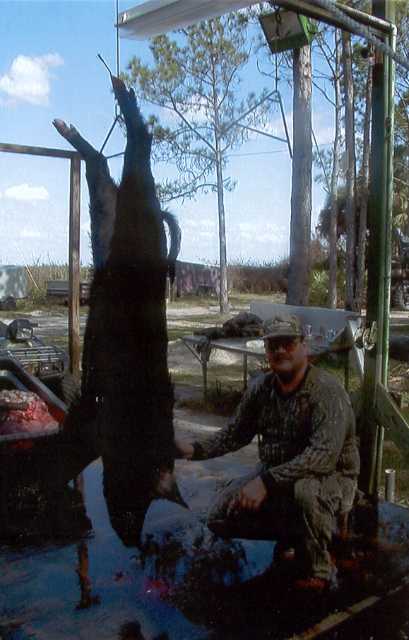|

In 1908 the Whiting Mfg. Co. of England purchased a large
tract of land which is now part of the Great Smokey Mtns. in Graham County, N.C. An American advisor for the company was allowed
to establish a game preserve on Hoopers Bald in 1909. After a 2 year construction project of enclosing appx.600 acres, the
wild boar preserve was completed. The hog lot was erected using split rail fencing nine rails high. In 1912 a shipment of
14 European wild hogs including, 11 sows and 3 boars each weighing appx. 60-75# were moved by ox drawn wagon to the mountain
and released in the lot. They were purchased from an agent in Berlin Germany who claimed they came from the Ural mountians
of Russia.
From the very beginning the lot was not hog proof and apparently some had escaped into the surrounding moutains
and quickly established themselves in North Carolina and boardering Tennesee. Today Hoopers Bald is owned by the U.S Forest
Service and is part of the Natahala Forest. As the wild boar thrived and expanded into the surrounding counties it was not
until 1936 that the first hunting season was allowed in the Cherokee National Forest and then in 1936 in the Natahala. In
1979 it was given the status of game animal by the N.C legislator.
Interbreeding between domestic pig stock and the wild
boar, along with trap and relocation programs to other areas of the U.S , has resulted in a huntable population across much
of the country except for the very coldest regins. South Carolina enjoys a thriving population in many counties, especially
those towards the coast.

Physical Characteristics:
The average weight for
a mature wild hog is around 100-200 lbs with those over 300 lbs being exceptional. Females will weigh appx. 20% less on the
hoof. Both sexes are capable of producing the much sought after prize, that being the tusk. These are simply canine teeth
which grow until they come into contact with one another and then turn and protrude towards the outside of the jaw line. Unlike
most animals with canines, the wild hogs canines continue to grow and are kept sharp by the constant "whetting "action as
the hog opens and closes it's mouth. Tusk on a mature hog can reach up to 4.5 inches on a trophy animal. On average, the boar
will stand 2-3 ft at the shoulders and are 3 1/2 to 5 feet in length. Wild hogs appear heavier in the shoulders than in the
hips , unlike their domestic relatives. The tail on the wild boar will also have course hair on the tip giving it a full appearence.

FOOD HABITS:
Wild hogs will consume practically
any type of fruit , nut or vegetation as well as vertabrate and invertabrate animals. Like their domestic cousins, they will
eat flowering plants, mushrooms, snails, snakes, bird eggs and even carrion. However; acorn mast is the prefered food and
the wild hog will travel great distances in pursuit of them. Often this competition for acorns causes problems for other mast
eating animals such as the whitetail deer and wild turkey. While hogs are mainly nocturnal, however there is some daytime
feeding activity. Baiting works well as these animals are oppurtunist and will revisit a bait station as long as scent is
kept to a minimun.

HUNTING METHODS:
Hunting with hounds has a long
and glorious history in the U.S beginning with the hunt on Hoopers Bald back in 1936. Hounds are set loose at either
scat sign or fresh tracks. After a trail is stuck, standers are positioned along likley escape routes or until a hog is bayed
by the dogs. More often than not , before the hunter can reach the area in which the hog has been bayed, he is off and running
again. Another method is to find some sort of recent activity and to bait heavily using corn or some type of fruit. Hogs are
predictable and will return to a bait station as long as sufficent food is available and that they are unaware of any human
presence. Wind direction is critical as wild hogs have a keen sense of smell on par with that of the whitetail deer.

SHOT PLACEMENT:
One of the most challenging ways
to hunt this animal is with archery equitment. Hogs can be difficult to put down if arrow placement is not precise. Wild hogs
have a protective sheild made of gristle which extends beyond the front shoulder and covering up the lungs. Heavy poundage
bows along with large diameter cut on impact broadheads will penetrate. However; experienced hog hunters know to wait until
the animal has presented a quartering away shot to slip the the arrow behind the plate and into the vitals. Hogs are a strong
and resilent game animal which leave little blood after being hit solidly with a razor sharp broadhead. A string tracker makes
quick recovery of downed game.
B.Stallings 11-02-01


|

